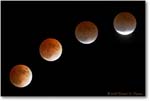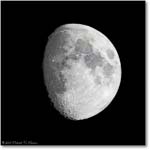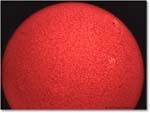Getting Started
 I
became fascinated with optics and the sky at an early age. I bought my
first telescope at 15 years with money earned mowing yards and selling
greeting cards door to door. The scope was a 4" Criterion Dynascope
Newtonian reflector with the original Criterion "Z" style equatorial
mount -- which consisted of a flimsy kink in the shaft that connected
the scope to the tripod. I was already well-read enough to know the
difference between spherical and parabolic mirrors, and when the
delivered scope showed unmistakable signs of spherical aberration I
promptly sent it back in exchange for a scope that met the advertising
claim of a "well-corrected parabolic mirror." The result was a scope
that formed excellent images and served for many years before being sold
for a pittance for use by the precocious daughter of a best friend. I
became fascinated with optics and the sky at an early age. I bought my
first telescope at 15 years with money earned mowing yards and selling
greeting cards door to door. The scope was a 4" Criterion Dynascope
Newtonian reflector with the original Criterion "Z" style equatorial
mount -- which consisted of a flimsy kink in the shaft that connected
the scope to the tripod. I was already well-read enough to know the
difference between spherical and parabolic mirrors, and when the
delivered scope showed unmistakable signs of spherical aberration I
promptly sent it back in exchange for a scope that met the advertising
claim of a "well-corrected parabolic mirror." The result was a scope
that formed excellent images and served for many years before being sold
for a pittance for use by the precocious daughter of a best friend.
Desperately Seeking Sharpness
 College,
a career in science and engineering, and a family intervened for a
couple of decades. But, when Halley's Comet reappeared in the mid-1980s
I got interested again and acquired a Meade 8" LX-3 SCT. This served
admirably for a few years, but eventually I became dissatisfied with
stars that were blobs instead of pinpoints at high powers. A subscriber
to both Sky & Telescope and Astronomy magazines, I began
to linger over ads from a small company in Rockford IL -- a new company
that was making high quality triplet apochromat refractors. Delightfully
and cleverly named Astro-Physics and owned by a truly innovative
perfectionist named Roland Christen, AP made APOs that promised the very
pinpoint star images I craved, so when the bank account permitted I took
the plunge, ordering a 130mm f8 Starfire EDT. The Starfire was a thing
of beauty, its white tube a ghostly luminesncent gleam by starlight, and
the images were every bit as sharp as advertised. College,
a career in science and engineering, and a family intervened for a
couple of decades. But, when Halley's Comet reappeared in the mid-1980s
I got interested again and acquired a Meade 8" LX-3 SCT. This served
admirably for a few years, but eventually I became dissatisfied with
stars that were blobs instead of pinpoints at high powers. A subscriber
to both Sky & Telescope and Astronomy magazines, I began
to linger over ads from a small company in Rockford IL -- a new company
that was making high quality triplet apochromat refractors. Delightfully
and cleverly named Astro-Physics and owned by a truly innovative
perfectionist named Roland Christen, AP made APOs that promised the very
pinpoint star images I craved, so when the bank account permitted I took
the plunge, ordering a 130mm f8 Starfire EDT. The Starfire was a thing
of beauty, its white tube a ghostly luminesncent gleam by starlight, and
the images were every bit as sharp as advertised.
 However,
there's a big difference between 130mm and the 203mm of the SCT, so I
was soon in the market again. Another few years of saving and sale of
the 130mm EDT led to the purchase of the AP 155mm f7 EDFS with FPL-53
glass and GTO mount, a classic scope that is still my favorite for
all-around observing. Now mounted on AP's Mach1 equatorial GTO head,
nothing beats the 155's combination of crystal sharpness, unsurpassed
contrast, moderate weight, great handling and flexibility. Since then
I've added the AP 130mm f6 EDFS, the 105mm Traveler and a William Optics
ZenithStar 66mm SD, which serves as a superfinder for the 155mm AP.
Wonderful scopes, all, especially when used with TeleVue's outstanding
Nagler eyepieces. However,
there's a big difference between 130mm and the 203mm of the SCT, so I
was soon in the market again. Another few years of saving and sale of
the 130mm EDT led to the purchase of the AP 155mm f7 EDFS with FPL-53
glass and GTO mount, a classic scope that is still my favorite for
all-around observing. Now mounted on AP's Mach1 equatorial GTO head,
nothing beats the 155's combination of crystal sharpness, unsurpassed
contrast, moderate weight, great handling and flexibility. Since then
I've added the AP 130mm f6 EDFS, the 105mm Traveler and a William Optics
ZenithStar 66mm SD, which serves as a superfinder for the 155mm AP.
Wonderful scopes, all, especially when used with TeleVue's outstanding
Nagler eyepieces.
Aperture Fever
But pinpoint star images aren't enough -- aperture
fever overtakes us all. The final piece of the puzzle fell into place
with the acquisition of a 16" truss Dob from Rick Singmaster's
Starmaster Portable Telescopes. Equipped with a
 mirror
by renowned maker Carl Zambuto, this scope breaks down into pieces that
are just within my size and weight limits. The images are nothing short
of phenomenal. Not only do faint planetaries reveal themselves and
galaxies begin to show structure but planets exhibit a plethora of tiny
low-contrast detail if the night is good enough to support the aperture.
The best view I've ever gotten of Saturn happened on a night that was so
heavily overcast with haze that the only objects visible (and faintly at
that!) were Saturn and a couple of first magnitude stars. But the
atmosphere was dead calm, and at 400X the view of Saturn in the Starmaster was
just spectacular -- including distinctive limb darkening, which is
difficult to see in small apertures! mirror
by renowned maker Carl Zambuto, this scope breaks down into pieces that
are just within my size and weight limits. The images are nothing short
of phenomenal. Not only do faint planetaries reveal themselves and
galaxies begin to show structure but planets exhibit a plethora of tiny
low-contrast detail if the night is good enough to support the aperture.
The best view I've ever gotten of Saturn happened on a night that was so
heavily overcast with haze that the only objects visible (and faintly at
that!) were Saturn and a couple of first magnitude stars. But the
atmosphere was dead calm, and at 400X the view of Saturn in the Starmaster was
just spectacular -- including distinctive limb darkening, which is
difficult to see in small apertures!
The Next Generation
Having lived the 50 year odessey described above
and enjoyed many beautiful views
 of
the night sky along the way, one of my favorite pastimes on the
telescope field these days is witnessing the surprise and wonder of
budding new young astronomers as they capture their first view of the
heavens at star parties. My all time favorite was the reaction of one
tiny young lady of no more than 8 years of age on first viewing Saturn.
She gasped in amazement, "That can't be Saturn; it must be painted on
the front of your telescope!" of
the night sky along the way, one of my favorite pastimes on the
telescope field these days is witnessing the surprise and wonder of
budding new young astronomers as they capture their first view of the
heavens at star parties. My all time favorite was the reaction of one
tiny young lady of no more than 8 years of age on first viewing Saturn.
She gasped in amazement, "That can't be Saturn; it must be painted on
the front of your telescope!"
Priceless! |


